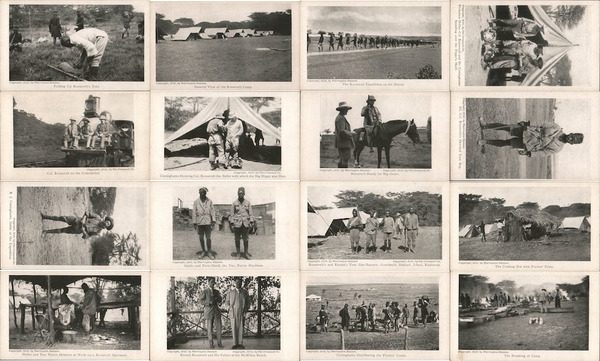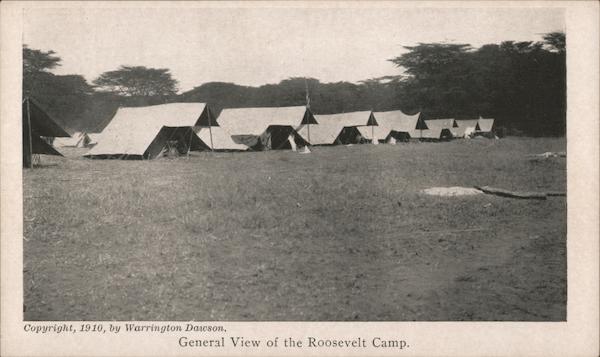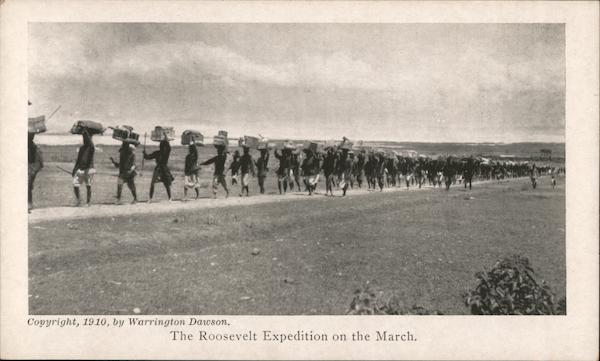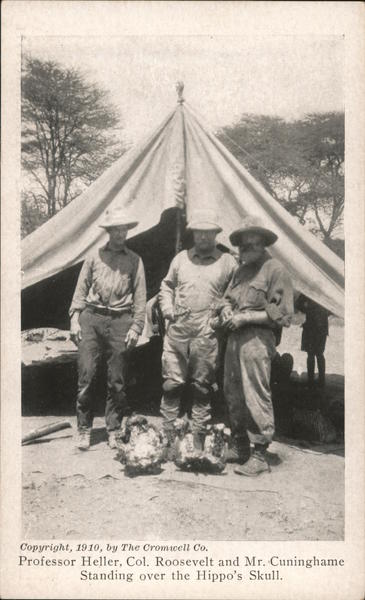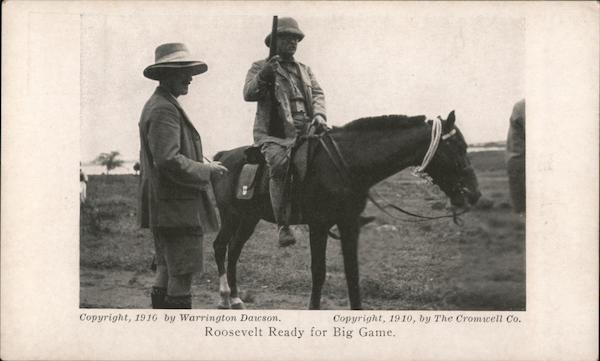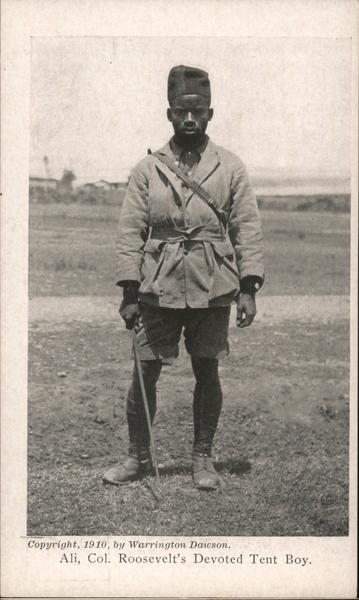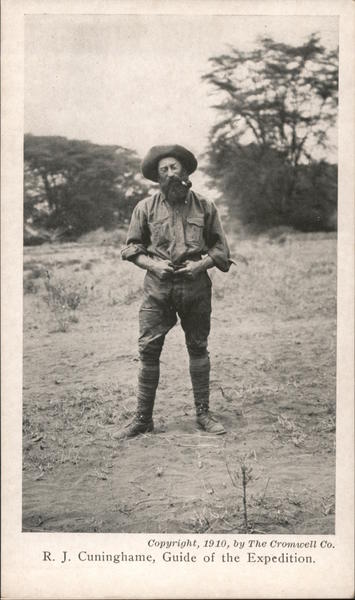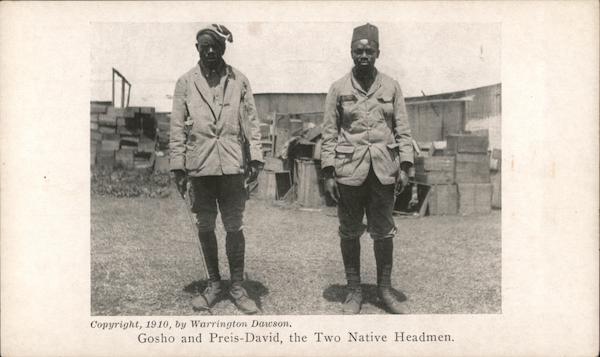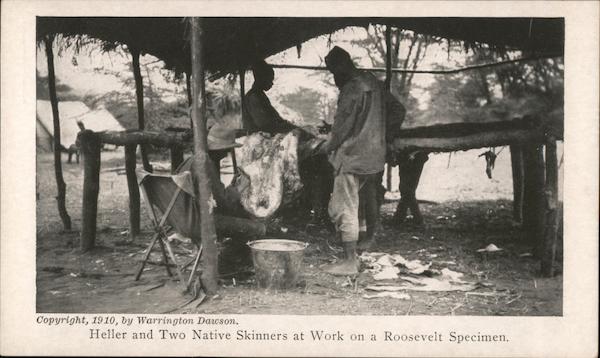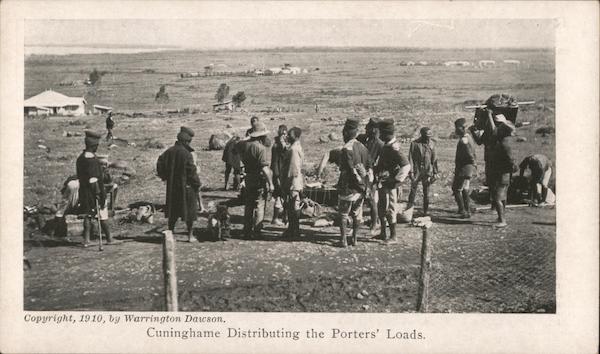Complete Set of 16: 1910 Roosevelt in Africa Series
Front:
Copyright, 1910, by Warrington Dawson.
Folding Up Roosevelt's Tent.
Copyright, 1910, by Warrington Dawson.
General View of the Roosevelt Camp.
Copyright, 1910, by Warrington Dawson.
The Roosevelt Expedition on the March.
wwww
Copyright, 1910, by The Cromwell Co.
Professor Heller, Col. Roosevelt and Mr. Cuninghame
Standing over the Hippo's Skull.
Copyright, 1910, by The Cromwell Co.
Col. Roosevelt on the Cowcatcher.
Copyright, 1910, by The Cromwell Co.
Cuninghame Showing Col. Roosevelt the Bullet with which the Big Hippo was Shot.
Copyright, 1910 by Warrington Dawson.
Copyright, 1910, by The Cromwell Co.
Roosevelt Ready for Big Game.
Copyright, 1910, by Warrington Dawson.
Ali, Col. Roosevelt's Devoted Tent Boy.
Copyright, 1910, by The Cromwell Co.
R. J. Cuninghame, Guide of the Expedition.
Copyright, 1910, by Warrington Dawson.
Gosho and Preis-David, the Two Native Headmen.
Copyright, 1910, by Warrington Dawson.
Conyright, 1910, by The Cromwell Co.
Roosevelt's and Kermit's Four Gun-Bearers: Gouvimale, Bakhari, Johari, Kasiturah.
Copyright, 1910, by Warrington Dawson.
The Cooking Hut with Porters' Tents.
Copyright, 1910, by Warrington Dawson.
Heller and Two Native Skinners at Work on a Roosevelt Specimen.
Copyright, 1910, by Warrington Dawson.
Copyright, 1910, by The Cromwell Co.
Kermit Roosevelt and His Father at the McMillan Ranch.
Copyright, 1910, by Warrington Dawson.
Cuninghame Distributing the Porters' Loads.
Copyright, 1910, by Warrington Dawson.
The Breaking of Camp.
Back:
ROOSEVELT IN AFRICA
A Series of 16 Cards Illustrating Roosevelt's Hunting Trip.
25 cents. The Cromwell Co., 434 Lafayette St., New York,
FOLDING ROOSEVELT’S TENT.—With the two
thicknesses of canvas separated, the poles taken out
and the ropes tied securely up into packages, por-
ters would carry Col. Roosevelt's tent easily on
their heads, round which they would first wrap
their blankets turban-fashion. When camp was
broken, Col. Roosevelt's was the last tent to go
down; when camp was pitched it was the first to go
up, always with the flag proudly put in place by
whichever porter had had the coveted honor of
carrying it on the march.
ROOSEVELT IN AFRICA
A Series of 16 Cards illustrating Roosevelt's Hunting Trip.
25 cents. The Cromwell Co., 434 Lafayette St., New York.
THE ROOSEVELT CAMP. Col. Roosevelt's tent is
marked by the Stars and Stripes, which always
floated over it, an object of veneration to the na-
tives. It was a double, tent, to afford protection
against the rays of the tropical sun. To one side
is Kermit's tent, to the other the dining tent. The
tents of the other white men on the expedition fill
the rest of the front row.
ROOSEVELT IN AFRICA
A Series of 16 Cards illustrating Roosevelt's Hunting Trip.
25 cents. The Cromwell Co., 434 Lafayette St., New York,
THE EXPEDITION ON THE MARCH.—The porters
swing off across the plain as if they carried noth-
ing; they talk and joke among themselves as they
go. At an average gait of three and a half miles
an hour they will cheerfully do some sixteen or
eighteen miles in a day, and on reaching the spot
where camp is to be pitched, they will put up the
tents and draw water and cut firewood before they
think of resting.
ROOSEVELT IN AFRICA
A Series of 16 Cards Illustrating Roosevelt's Hunting Trip.
25 cents. The Cromwell Co., 434 Lafayette St., New York,
ROOSEVELT AND THE HIPPO’S SKULL.—Col.
Roosevelt had had an exciting adventure on Lake
Naivasha with this hippopotamus, which charged,
open-mouthed, the rowboat in which were Col.
Roosevelt, Kermit and Cuninghame. While Col.
Roosevelt was firing, Kermit was coolly taking the
creature's picture. Col. Roosevelt was much im-
pressed with the quickness of these great short-
legged, ungainly beasts.
ROOSEVELT IN AFRICA
A Series of 16 Cards illustrating Roosevelt's Hunting Trip.
25 cents. The Cromwell Co., 434 Lafayette St., New York.
INTO THE GAME COUNTRY.—Col. Roosevelt be-
gan his African experiences by a novel ride on the
cowcatcher of an engine to view the wild animals
with which the country abounds. They come up
within full sight of the railroad track, and are in-
deed sometimes killed by the cars. In the picture,
R. J. Cuninghame, the guide of the expedition, is
seated next to Col. Roosevelt, and next to Cuning-
hame is Dr. Edgar A. Mearns, the scientist.
ROOSEVELT IN AFRICA
A Series of 16 Cards illustrating Roosevelt's Hunting Trip.
25 cents. The Cromwell Co., 434 Lafayette St., New York.
THE BULLET THAT KILLED THE BIG HIPPO.-
Col. Roosevelt was making an experiment in big-
game shooting by using a full-jacketed bullet with
a repeating rifle. The results proved highly satis-
factory in this case and in others, the bullet flat-
tening just enough to kill promptly without doing
unnecessary damage to the specimen.
ROOSEVELT IN AFRICA
A Series of 16 Cards illustrating Roosevelt's Hunting Trip.
25 cents, The Cromwell Co., 434 Lafayette St., New York.
ROOSEVELT ON “TRANQUILLITY.”—Mounted on
his horse “Tranquillity,” his repeating rifle in his
hand, Col. Roosevelt is ready to start off for a day's
shooting. Before firing, he will dismount to get a
perfect aim, for he never pulls the trigger until he
is sure that he has covered his quarry, and the
more dangerous the animal the more deliberate he
will be. Meanwhile, “Tranquillity,” his horse, will
remain quietly near him, not requiring to be held
or tied.
ROOSEVELT IN AFRICA
A Series of 16 Cards illustrating Roosevelt's Hunting Trip.
25 cents. The Cromwell Co., 434 Lafayette St., New York.
ALI, ROOSEVELT'S DEVOTED TENT BOY.-
A half-Arabian, half-Swahili
half-Swahili coast native, who
served Col. Roosevelt during the entire African
trip. Ali was much impressed by the fact that
Col. Roosevelt always had Mrs. Roosevelt's photo-
graph near him, and he would keep it in the tent
always turned so as to face Col. Roosevelt.
ROOSEVELT IN AFRICA
A Series of 16 Cards illustrating Roosevelt's Hunting Trip.
25 cents. The Cromwell Co., 434 Lafayette St., New York.
CUNINGHAME, GUIDE OF THE EXPEDITION.-
One of the most experienced guides in Africa, who
shared with Col. Roosevelt the task of planning the
entire expedition. He was responsible for manag-
ing the supplies and the natives.
ROOSEVELT IN AFRICA
A Series of 16 Cards illustrating Roosevelt's Hunting Trip.
25 cents. The Crorwell Co., 434 Lafayette St., New York.
THE TWO NATIVE HEADMEN.—These headmen
were the intermediaries between Cuninghame and
the porters and were responsible for the good con-
duct of the latter. The taller of the two, Preis-
David, was a mission boy, and, as his work was
very efficient, Col. Roosevelt would quote his case
whenever he heard the character of mission boys
run down by East Africans.
ROOSEVELT IN AFRICA
A Series of 16 Cards illustrating Roosevelt's Hunting Trip.
25 cents. The Cromwell Co., 434 Lafayette St., New York.
THE FOUR GUN-BEARERS.-In a country in-
fested by dangerous game it is always necessary to
have an extra gun-bearer with a relief gun, so Col.
Roosevelt and Kermit were provided with two each.
These gun-bearers sometimes show extraordinary
courage, risking their lives to save their masters.
Kermit Roosevelt appears in the rear.
ROOSEVELT IN AFRICA
A Series of 16 Cards illustrating Roosevelt's Hunting Trip.
25 cents. The Cromwell Co., 434 Lafayette St., New York.
THE COOKING HUT.—The cooking was always
done in a hut of poles and elephant-grass built by
the natives wherever camp was pitched. Four to
six porters slept in each little tent. Col. Roosevelt
objected to this discomfort for them and ordered
roomier quarters, but they objected saying they
got cold at night unless they lay in bunches.
ROOSEVELT IN AFRICA
A Series of 16 Cards illustrating Roosevelt's Hunting Trip.
25 cents. The Cromwell Co., 434 Lafayette St, New York.
One Ceut
AT WORK ON A SPECIMEN.- Edmund Heller, the
naturalist, found great difficulty in training natives
to help him in the skinning of the specimens, un-
til he noticed that while the natives of the Swahili
tribe liked only rice, the Kikuyus only beans, the
Masai only milk mixed with blood, the Wakamba
tribe liked raw meat, which they tore with filed
teeth. He therefore concentrated his attention on
Wakamba, since they seemed predisposed by their
tribal customs to have an interest in animals, and
he succeeded in making excellent skinners of several.
ROOSEVELT IN AFRICA
A Series of 16 Cards illustrating Roosevelt's Hunting Trip.
25 cents. The Cromwell Co., 434 Lafayette St., New York.
ROOSEVELT AND KERMIT AT THE MCMILLAN
RANCH. —Every few weeks Col.
Col. Roosevelt and
Kermit would come back to Nairobi and stop at the
house of W. N. McMillan, of St. Louis, to get in
touch with civilization once more. They are here
represented on the veranda of Mr. McMillan's house.
ROOSEVELT IN AFRICA
A Series of 16 Cards Illustrating Roosevelt's Hunting Trip.
25 cents. The Cromwell Co., 434 Lafayette St., New York.
One Ceut
DISTRIBUTING THE PORTER'S LOADS.—Just be-
fore the march begins, Cuninghame verifies the
packing and binding of the important pieces of
luggage, and sees that an equitable distribution of
the loads is made. Each porter then puts down his
allotted load in front of him, waiting for the signal
to start.
ROOSEVELT IN AFRICA
A Series of 16 Cards illustrating Roosevelt's Hunting Trip.
25 cents. The Cromwell Co., 434 Lafayette St., New York.
BREAKING CAMP.—Tents, provisions, equipments
for the trip, the salt, arsenic, cotton-batting and
everything required by the naturalists, are packe,
up in loads averaging fifty pounds, but on no con-
sideration exceeding sixty. On account of the scien-
tific nature of this expedition, causing all specimens
to he preserved, 240 porters were required.

